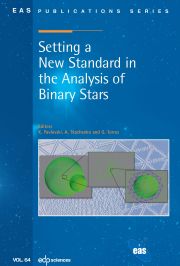No CrossRef data available.
Article contents
Cooling-Induced Structures in Collapsar AccretionDisks
Published online by Cambridge University Press: 22 July 2013
Abstract
The collapse of massive rotating stellar cores and the associated accretion is thought topower long Gamma ray bursts. The physical conditions make neutrino emission the maincooling agent in the flow. We have carried out an initial set of calculations of thecollapse of rotating polytropic cores in three dimensions, making use of apseudo-relativistic potential and a simplified cooling prescription. We focus on theeffects of self gravity and cooling on the overall morphology and evolution of the flowfor a given rotation rate in the context of the collapsar model. For the typical coolingtimes expected in such a scenario we observe the appearance of strong instabilities on atime scale tcool following disk formation.Such instabilities and their gravitational interaction with the black hole producesignificant variability in the obtained accretion rates, which would translate intoluminosity variations when a more realistic neutrino cooling and luminosity scheme isimplemented in future work.
- Type
- Research Article
- Information
- Copyright
- © EAS, EDP Sciences 2013


